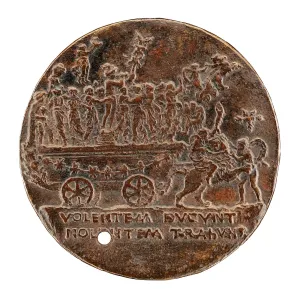Antonio Graziadei (d. 1492)
Bertoldo di Giovanni (ca. 1440–1491)
Antonio Graziadei (d. 1492), ca. 1480
Bronze
2 1/2 in. (6 cm)
National Gallery of Art, Washington, Samuel H. Kress Collection (1957.14.844)
Inscription: VOLENTEM DVCVNT / NOLENTEM TRAhVNT [They lead the willing and drag the unwilling]
Reverse exhibited | See exhibited obverse
Courtesy National Gallery of Art, Washington
The Venetian Antonio Graziadei was a Franciscan friar celebrated for his study of astrology, but Bertoldo's medal identifies him as an imperial ambassador, a position he held in Florence in 1480. Graziadei moved in the circles of Holy Roman Emperor Frederick III, whose medal by Bertoldo (also included in the exhibition) perhaps inspired Graziadei to commission his own. The reverse celebrates Graziadei's political role. Holding the caduceus and playing a pipe, Mercury — god of eloquence and messenger of the gods — stands on a cart accompanied by the nine Muses, indicating how the arts complement the diplomatic skills of Graziadei. Above, the goddess Diana holds a crescent moon, and Apollo drives his chariot. The cart is pulled by a lion ridden by a female with a trumpet, representing fame. The triumphal scene and inscriptions glorify Graziadei's ambassadorial role, yet the representations of Mercury, Diana, Apollo, and the stars adorning the cart may be linked to Graziadei's astrological erudition.


